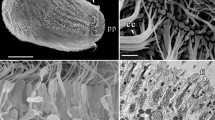Summary
Twenty-one species of Porifera have been surveyed by light microscopy for the presence, form, and relative abundance of a little known cell type known as central cells. They are found to be present in fifteen of these species and occur in six morphologically recognizable forms. Their functional roles are reinterpreted in the light of new distributional and abundance data. The central cells of the siliceous ceractinomorph demosponges are common and intimately associated with the choanocyte population. They probably play an important role in control of water currents within individual choanocyte chambers to mediate cleaning of the outer chamber surfaces. The central cells of keratosan and tetractinomorph demosponges appear to represent stages in egestive processes of wandering mesenchyme cells.
Similar content being viewed by others
References
Brien, P.: Les Démosponges. In: Traité de Zoologie, Vol.3, pp. 133–461 (P.P. Grassé, ed.). Paris: Masson 1973
Connes, R., Diaz, J-P., Paris, J.: Choanocytes et cellule centrale chez la DémospongeSuberites massa Nardo. C.R. Acad. Sc. Paris,273, 1590–1593 (1971)
Delage, Y.: Embryogenèse des Eponges. Arch. Zool. exp. et gén.10, 345–498 (1892)
Delage, Y., Hérouard, E.: Traité de Zoologie croncrète, Vol. 2, Spongiaires. Paris: Le Soudier 1899
Duboscq, O., Tuzet, O.: Les diverses formes des Choanocytes des Eponges calcaires hétérocoeles et leur signification. Arch. Zool. exp. et gén.80, 353–358 (1939)
Fauré-Frémiet, M.E.: Etude histologique deFiculina ficus L. (Demospongia). Arch. Anat. micr.27, 421–449 (1931)
Hartman, W.D.: Phylum Porifera. In: Light's manual: Intertidal invertebrates of the Central California Coast, pp. 32–64 (R.I. Smith, J.T. Carlton, eds.). Berkeley, Calif. U.C. Press 1975
Hartman, W.D., Goreau, T.F.: A Pacific tabulate sponge, living representative of a new order of sclerosponges. Postula167, 1–14 (1975)
Humason, G.L.: Animal tissue techniques, San Francisco: Freeman 1962
Lévi, C.: Systématique de la class Demospongiaria (Demosponges). In: Traité de Zoologie, Vol.3, pp. 577–631 (P.P. Grasse, ed.). Paris: Masson 1973
Maas, O.: über Involutionserscheinungen bei SchwÄmmen und ihre Bedeutung für die Auffassung des Spongienkörpers. Festschrift F.R. Hertwig3, 93–130 (1910)
Pavans de Ceccatty, M.: Le systeme nerveux des Eponges calcaires et siliceuses. Ann. Sci. nat. Zool.17, 203–288 (1955)
Reiswig, H.M.: In situ pumping activities of tropical Demospongiae. Mar. Biol.9, 38–50 (1971a)
Reiswig, H.M.: Particle feeding in natural populations of three marine Demospongiae. Biol. Bull. Mar. Biol. lab. (Woods Hole)141, 568–591 (1971b)
Sollas, W.J.: Tetractinellida. Challenger Repts. Zool.25, 1–458 (1888)
Tuzet, O.: Eponges Calcaires. In: Traité de Zoologie, Vol. 3, pp. 27–132 (P.P. Grassé, ed.). Paris: Masson 1973
Author information
Authors and Affiliations
Additional information
This investigation was supported by an operating grant, No. A9554, from the National Research Council of Canada
Rights and permissions
About this article
Cite this article
Reiswig, H.M., Brown, M.J. The central cells of sponges. Zoomorphologie 88, 81–94 (1977). https://doi.org/10.1007/BF01880648
Received:
Issue Date:
DOI: https://doi.org/10.1007/BF01880648




